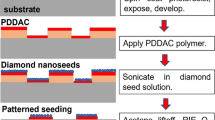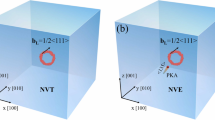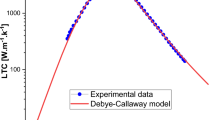Abstract
Understanding the interaction between atomic hydrogen and solid tungsten is important for the development of fusion reactors in which proposed tungsten walls would be bombarded with high energy particles including hydrogen isotopes. Here, we report results from periodic density-functional theory calculations for three crucial aspects of this interaction: surface-to-subsurface diffusion of H into W, trapping of H at vacancies, and H-enhanced decohesion, with a view to assess the likely extent of hydrogen isotope incorporation into tungsten reactor walls. We find energy barriers of (at least) 2.08 eV and 1.77 eV for H uptake (inward diffusion) into W(001) and W(110) surfaces, respectively, along with very small barriers for the reverse process (outward diffusion). Although H dissolution in defect-free bulk W is predicted to be endothermic, vacancies in bulk W are predicted to exothermically trap multiple H atoms. Furthermore, adsorbed hydrogen is predicted to greatly stabilize W surfaces such that decohesion (fracture) may result from high local H concentrations.
Similar content being viewed by others
References
R. Toschi, P. Barabaschi, D. Campbell, F. Elio, D. Maisonnier, D. Ward How far is a fusion power reactor from an experimental reactor. Fusion Eng. Des. 56–57, 163 (2001)
H. Bolt, V. Barabash, W. Krauss, J. Linke, R. Neu, S. Suzuki, N. Yoshida Materials for the plasma-facing components of fusion reactors. J. Nucl. Mater. 329–33, 66 (2004)
J.B. Condon, T. Schober Hydrogen bubbles in metals. J. Nucl. Mater. 207, 1 (1993)
D. Naujoks, K. Asmussen, Bessenrodt-M. Weberpals, S. Deschka, R. Dux, W. Engelhardt, A.R. Field, G. Fussmann, J.C. Fuchs, C. García-Rosales, S. Hirsch, P. Ignacz, G. Lieder, K.F. Mast, R. Neu, R. Radtke, J. Roth, U. Wenzel Tungsten as target material in fusion devices. Nucl. Fusion 36, 671 (1996)
M. Kaufmann, R. Neu Tungsten as first wall material in fusion devices. Fusion Eng. Des. 82, 521 (2007)
E. Serra, G. Benamati, O.V. Ogorodnikova Hydrogen isotopes transport parameters in fusion reactor materials. J. Nucl. Mater. 255, 105 (1998)
W.M. Shu, A. Kawasuso, Y. Miwa, E. Wakai, G.N. Luo, T. Yamanishi Microstructure dependence of deuterium retention and blistering in the near-surface region of tungsten exposed to high flux deuterium plasmas of 38 eV at 315K. Phys. Scr. T. 128, 96 (2007)
V.K. Alimov, J. Roth, M. Mayer Depth distribution of deuterium in single- and polycrystalline tungsten up to depths of several micrometers. J. Nucl. Mater. 337, 619 (2005)
M. Poon, Macaulay-R.G. Newcombe, J.W. Davis, A.A. Haasz Effects of background gas impurities during D+ irradiation on D trapping in single crystal tungsten. J. Nucl. Mater. 337, 629 (2005)
T.E. Felter, R.A. Barker, P.J. Estrup Phase-transition on Mo(100) and W(100) surfaces. Phys. Rev. Lett. 38, 1138 (1977)
M.K. Debe, D.A. King Clean thermally induced W[001](1 × 1)-]() R 45° surface-structure transition and its crystallography. Surf. Sci. 81, 193 (1979)
R.A. Barker, P.J. Estrup Surface-structures and phase-diagram for the H-W(001) chemisorption system. J. Chem. Phys. 74, 1442 (1981)
D.A. King Clean and adsorbate-induced surface phase-transitions on W(100). Phys. Scr. T. 4, 34 (1983)
H. Landskron, N. Bickel, K. Heinz, G. Schmidtlein, K. Muller LEED intensity analysis of the clean W(100) C(2x2) surface reconstruction. J. Phys. Condens. Matter 1, 1 (1989)
M.S. Altman, P.J. Estrup, I.K. Robinson Multilayer reconstruction of the W(001) surface. Phys. Rev. B 38, 5211 (1988)
I. Stensgaard, L.C. Feldman, P.J. Silverman Reconstruction of the W(001) surface and its reordering by hydrogen adsorption, studied by MEV ion scattering. Phys. Rev. Lett. 42, 247 (1979)
K.S. Shin, H.W. Kim, J.W. Chung Evidence for a driving mechanism of the W(001) reconstruction. Surf. Sci. 385, L978 (1997)
R. Yu, H. Krakauer, D. Singh Equilibrium geometry and electronic-structure of the low-temperature W(001) surface. Phys. Rev. B 45, 8671 (1992)
W. Xu, J.B. Adams Structure of 7 W-surfaces. Surf. Sci. 319, 45 (1994)
H.L. Meyerheim, D. Sander, R. Popescu, P. Steadman, S. Ferrer, J. Kirschner Interlayer relaxation of W(110) studied by surface x-ray diffraction. Surf. Sci. 475, 103 (2001)
M. Arnold, G. Hupfauer, P. Bayer, L. Hammer, K. Heinz, B. Kohler, M. Scheffler Hydrogen on W(110): An adsorption structure revisited. Surf. Sci. 382, 288 (1997)
P.J. Estrup, J. Anderson Chemisorption of hydrogen on tungsten (100). J. Chem. Phys. 45, 2254 (1966)
R.A. Barker, P.J. Estrup Hydrogen on tungsten (100) adsorbate induced surface reconstruction. Phys. Rev. Lett. 41, 1307 (1978)
D.A. King, G. Thomas Displacive surface phases formed by hydrogen chemisorption on W(001). Surf. Sci. 92, 201 (1980)
A.H. Smith, R.A. Barker, P.J. Estrup Desorption of hydrogen from tungsten (100). Surf. Sci. 136, 327 (1984)
P.W. Tamm, L.D. Schmidt Binding states of hydrogen on tungsten. J. Chem. Phys. 54, 4775 (1971)
E.W. Plummer, A.E. Bell Field-emission energy-distributions of hydrogen and deuterium on (100) and (110) planes of tungsten. J. Vac. Sci. Technol. 9, 583 (1972)
J.B. Restorff, H.D. Drew Surface reflectance spectroscopy of hydrogen chemisorbed on W(100), W(110) and W(111). Surf. Sci. 88, 399 (1979)
R. Difoggio, R. Gomer Diffusion of hydrogen and deuterium on the (110) plane of tungsten. Phys. Rev. B 25, 3490 (1982)
S.C. Wang, R. Gomer Diffusion of hydrogen, deuterium, and tritium on the (110) plane of tungsten. J. Chem. Phys. 83, 4193 (1985)
C. Dharmadhikari, R. Gomer Diffusion of hydrogen and deuterium on the (111) plane of tungsten. Surf. Sci. 143, 223 (1984)
O. Grizzi, M. Shi, H. Bu, J.W. Rabalais, R.R. Rye, P. Nordlander Determination of the structure of hydrogen on a W(211) surface. Phys. Rev. Lett. 63, 1408 (1989)
H.W. Fink, G. Ehrlich Lattice steps and adatom binding on W(211). Surf. Sci. 143, 125 (1984)
P.G. Flahive, W.R. Graham Determination of single atom surface site geometry on W(111), W(211) and W(321). Surf. Sci. 91, 463 (1980)
R.R. Rye, B.D. Barford, P.G. Cartier Chemisorption of H2 on W(211). J. Chem. Phys. 59, 1693 (1973)
T.B. Grimley, M. Torrini Interaction between two hydrogen atoms adsorbed on (100) tungsten. J. Phys. C: Solid State Phys. 6, 868 (1973)
K.O.E. Henriksson, K. Vortler, S. Dreissigacker, K. Nordlund, J. Keinonen Sticking of atomic hydrogen on the tungsten (001) surface. Surf. Sci. 600, 3167 (2006)
J. Zhang, Y.J. Yu, Z.X. Wang, W.N. Qin, Z.Y. Diao, C. Hao Adsorption sites and states for H atom on W low-index surfaces. Acta Chim. Sinica 65, 785 (2007)
H.F. Busnengo, A.E. Martinez H2 chemisorption on W(100) and W(110) surfaces. J. Phys. Chem. C 112, 5579 (2008)
A. Nojima, K. Yamashita A theoretical study of hydrogen adsorption and diffusion on a W(110) surface. Surf. Sci. 601, 3003 (2007)
J.A. White, D.M. Bird, M.C. Payne Dissociation of H2 on W(100). Phys. Rev. B 53, 1667 (1996)
R. Difoggio, R. Gomer Tunneling of hydrogen in surface-diffusion on the tungsten-(110) plane. Phys. Rev. Lett. 44, 1258 (1980)
M. Kay, G.R. Darling, S. Holloway Comparing quantum and classical dynamics: H2 dissociation on W(100). J. Chem. Phys. 108, 4614 (1998)
R. Frauenfelder Solution and diffusion of hydrogen in tungsten. J. Vac. Sci. Technol. 6, 388 (1969)
Y. Hayashi, W.M. Shu Iron (ruthenium and osmium)-hydrogen systems. Solid State Phenom. 73–75, 65 (2000)
K.O.E. Henriksson, K. Nordlund, A. Krasheninnikov, J. Keinonen Difference in formation of hydrogen and helium clusters in tungsten. Appl. Phys. Lett. 87, 3 (2005)
Y.L. Liu, Y. Zhang, G.N. Luo, G.H. Lu Structure, stability and diffusion of hydrogen in tungsten: A first-principles study. J. Nucl. Mater. 390–391, 1032 (2009)
H. Jónsson, G. Mills, K.W. Jacobsen Nudged elastic band method for finding minimum energy paths of transitions Classical and Quantum Dynamics in Condensed Phase Simulations edited by B.J. Berne, G. Ciccotti, and D.F. Coker (World Scientific, Singapore 1998) 385
S.T. Picraux, F.L. Vook Deuterium lattice location in Cr and W. Phys. Rev. Lett. 33, 1216 (1974)
R.A. Anderl, D.F. Holland, G.R. Longhurst, R.J. Pawelko, C.L. Trybus, C.H. Sellers Deuterium transport and trapping in polycrystalline tungsten. Fusion Technol. 21, 745 (1992)
K.L. Wilson, R. Bastasz, R.A. Causey, D.K. Brice, B.L. Doyle, W.R. Wampler, W. Moller, B.M.U. Scherzer, T. Tanabe Trapping, detrapping and release of implanted hydrogen isotopes. Nucl. Fusion 1, 31 (1991)
M. Poon, A.A. Haasz, J.W. Davis Modelling deuterium release during thermal desorption of D+-irradiated tungsten. J. Nucl. Mater. 374, 390 (2008)
T.J. Venhaus, R.A. Causey Analysis of thermal desorption spectra to understand the migration of hydrogen in tungsten. Fusion Technol. 39, 868 (2001)
A.S. Soltan, R. Vassen, P. Jung Migration and immobilization of hydrogen and helium in gold and tungsten at low temperatures. J. Appl. Phys. 70, 793 (1991)
J.R. Fransens, M.S.A. Elkeriem, F. Pleiter Hydrogen vacancy interaction in tungsten. J. Phys. Condens. Matter 3, 9871 (1991)
Y.L. Liu, Y. Zhang, H.B. Zhou, G.H. Lu, F. Liu, G.N. Luo Vacancy trapping mechanism for hydrogen bubble formation in metal. Phys. Rev. B 79, 4 (2009)
D.E. Jiang, E.A. Carter First principles assessment of ideal fracture energies of materials with mobile impurities: Implications for hydrogen embrittlement of metals. Acta Mater. 52, 4801 (2004)
G. Kresse, J. Furthmuller Efficient iterative schemes for ab initio total-energy calculations using a plane-wave basis set. Phys. Rev. B 54, 11169 (1996)
G. Kresse, J. Furthmuller Efficiency of ab-initio total energy calculations for metals and semiconductors using a plane-wave basis set. Comput. Mater. Sci. 6, 15 (1996)
G. Kresse, D. Joubert From ultrasoft pseudopotentials to the projector augmented-wave method. Phys. Rev. B 59, 1758 (1999)
P.E. Blochl Projector augmented-wave method. Phys. Rev. B 50, 17953 (1994)
J.P. Perdew, K. Burke, M. Ernzerhof Generalized gradient approximation made simple. Phys. Rev. Lett. 77, 3865 (1996)
M. Methfessel, A.T. Paxton High-precision sampling for brillouin-zone integration in metals. Phys. Rev. B 40, 3616 (1989)
K.W. Kwak, M.Y. Chou, N. Troullier First-principles study of the H-induced reconstruction of W(110). Phys. Rev. B 53, 13734 (1996)
C. Kittel Introduction to Solid State Physics 7th ed. (John Wiley & Sons, Inc., New York 2002)
K.P. Huber, G. Herzberg Molecular Spectra and Molecular Structure IV: Constants of Diatomic Molecules (Van Norstrand Reinhold Co., New York 1979)
G.H. Vineyard Frequency factors and isotope effects in solid state rate processes. J. Phys. Chem. Solids 3, 121 (1957)
H.B. Huntington, G.A. Shirn, E.S. Wajda Calculation of the entropies of lattice defects. Phys. Rev. 99, 1085 (1955)
J. Harris, S. Andersson H2 dissociation at metal surfaces. Phys. Rev. Lett. 55, 1583 (1985)
C. Wert, C. Zener Interstitial atomic diffusion coefficients. Phys. Rev. 76, 1169 (1949)
R. Frauenfelder Solution and diffusion of hydrogen in tungsten. J. Vacuum Sci. Technol. 6, 388 (1969)
A. Devita, M.J. Gillan The ab initio calculation of defect energetics in aluminum. J. Phys. Condens. Matter 3, 6225 (1991)
Y. Tateyama, T. Ohno Stability and clusterization of hydrogen vacancy complexes in alpha-Fe: An ab initio study. Phys. Rev. B 67, 174105 (2003)
A. Ramasubramaniam, M. Itakura, E.A. Carter Interatomic potentials for hydrogen in alpha-iron based on density-functional theory. Phys. Rev. B 79, 174101 (2009)
Y. Fukai Superabundant vacancies formed in metal-hydrogen alloys. Phys. Scr. T. 103, 11 (2003)
Y. Fukai, N. Okuma Formation of superabundant vacancies in Pd hydride under high hydrogen pressures. Phys. Rev. Lett. 73, 1640 (1994)
G. Lu, E. Kaxiras Hydrogen embrittlement of aluminum: The crucial role of vacancies. Phys. Rev. Lett. 94, 4 (2005)
D.C. Sorescu First-principles calculations of the adsorption and diffusion of hydrogen on Fe(100) surface and in the bulk. Catal. Today 105, 44 (2005)
G.N. Luo, W.M. Shu, M. Nishi Influence of blistering on deuterium retention in tungsten irradiated by high flux deuterium 10–100 eV plasmas. Fusion Eng. Des. 81, 957 (2006)
K. Momma, F. Izumi VESTA: A three-dimensional visualization system for electronic and structural analysis. J. Appl. Crystallogr. 41, 653 (2008)
Author information
Authors and Affiliations
Corresponding author
Rights and permissions
About this article
Cite this article
Johnson, D.F., Carter, E.A. Hydrogen in tungsten: Absorption, diffusion, vacancy trapping, and decohesion. Journal of Materials Research 25, 315–327 (2010). https://doi.org/10.1557/JMR.2010.0036
Received:
Accepted:
Published:
Issue Date:
DOI: https://doi.org/10.1557/JMR.2010.0036




